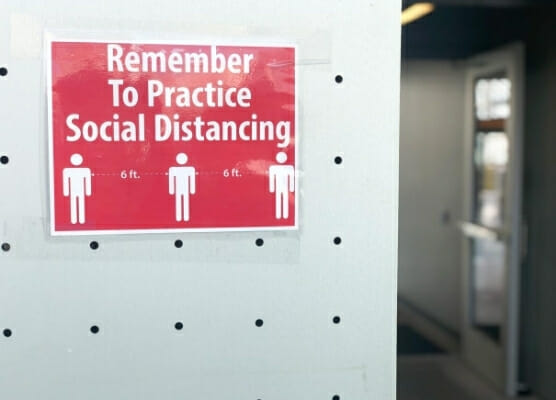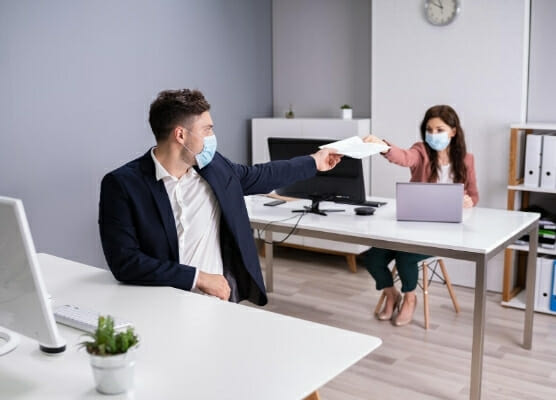The top safety concerns workers have … and how to address them
 As COVID-19 has spread worldwide, businesses are now faced with the challenge of reopening safely and minimizing employee risk.
As COVID-19 has spread worldwide, businesses are now faced with the challenge of reopening safely and minimizing employee risk.
So what can be done to keep employees safe?
First, companies should stay informed about the guidelines in place from the Centers for Disease Control (CDC) and other local, state, and national entities. The CDC recommends tailoring your opening approach based on the rate of transmission in the local community.
Employers should consider a plan to open while still slowing the spread – using measures to prevent and reduce transmission among employees and maintaining a healthy work environment.
Proper planning to address employees who may be at higher risk, employees who become infected, and protocols for how to maintain business continuity while staying safe should be created.
“A Harris Poll of 2,000 U.S. workers says these are the top five safety measures (in order) they feel would be critical to help them feel safe in their workplace.”
Social distancing measures
For those employees who simply cannot work from home, the current guidance recommends social distancing as one measure to protect workers.
Social distancing can help reduce the spread of the virus, as it happens most easily when there is prolonged close contact.
Social distancing at work means establishing 6 feet of distance between employees – this helps reduce the spread of the Coronavirus. Some ways to help facilitate social distancing are:
- Adjusting workspaces so that they are further apart
- Adding partitions or plexiglass
- Marking floors for one-way traffic
- Mark floors for distancing at areas where there might be lines, such as the cafeteria.
- Consider staggering work breaks so that employees are not congregating in break areas or cafeterias.
Setting policies that enable flexible work can help employees maintain physical and social distance. Think about:
- Allowing employees to work from home.
- Staggering shifts or rotating hours, so fewer employees are in the office at one time.
- Increasing the space between work areas.
- Adding partitions between people.
- Using visual markers to help people maintain distance.
- Changing cafeteria service and closing areas where large groups gather.
- Providing options for drive-through, delivery, or no-contact services for customers.
It might be helpful for employees to be prepared to enforce their boundaries by speaking up if they feel uncomfortable or if someone is invading their space. Some things employees could say include:
- Would you mind backing up a little? I am trying to stay safe and socially distant at all times.
- Can we have this conversation using video chat or via a phone call?
- I’m trying to maintain social distance for safety reasons; I am going to move over here while we talk.
- I’m going to put my mask on, would you mind putting yours on too?
 Extra cleaning protocols
Extra cleaning protocols
One of the ways to prevent the spread of COVID-19 is through enhanced cleaning protocols.
Disinfecting high touch surfaces such as tables, light switches, doorknobs, desks, countertops, bathrooms, phones, shopping carts, displays, credit card readers, and keyboards should be a priority as businesses reopen.
- Employees should be encouraged to wash their hands frequently with soap and water and regularly use an alcohol-based hand sanitizer that contains at least 60% alcohol.
- Additional reminders about general hygiene may also be helpful – encourage employees to wash hands after blowing their nose, before preparing or eating food, after using the restroom, and before and after providing care to others.
- Ask employees not to share desks, phones, offices, and tools – and if they must be shared, give the proper disinfecting equipment so they can be cleaned between use.
- Provide any necessary personal protective equipment (PPE) to employees in jobs that require it.
- Provide disinfecting wipes, cleaner, or sprays for employees to use when cleaning and train them on their use.
- Implement a process for routine cleaning and disinfecting of surfaces and equipment.
If you’ve reopened and an employee becomes sick, even further cleaning measures will be required. The first step is to close any areas used by the infected employee and wait 24 hours to begin the disinfecting process. All areas used by the infected employee should be disinfected.
Covid-19 testing offered to staff
The CDC has issued guidance regarding when COVID-19 testing should be provided for employees.
Also, testing falls under the Americans with Disabilities Act (ADA) guidelines. “The ADA requires that any mandatory medical test of employees be “job-related and consistent with business necessity.”
Since someone with the virus can infect other employees, businesses may opt to test employees before they are cleared to come to work.
Employers should be sure that tests are accurate, following the guidance of the Food and Drug Administration (FDA).
Even with testing, employers must encourage other measures to ensure employees are safe when returning to work – because those with the virus can be asymptomatic, following all the recommendations in addition to testing is vital to employee wellness.
The Equal Employment Opportunity Commission (EEOC) has determined that employer testing rights do not extend to antibody testing.
 Masks required in the workplace
Masks required in the workplace
In some locations, masks may be mandated by government order.
In other instances, the store, business owner, or workplace may require employees to wear a cloth mask or face covering. Particularly when social distancing is not an option, encouraging or mandating the wearing of masks can help to protect employees and customers alike.
Some employers are providing cloth masks for employees who do not have their own, to encourage use. The CDC recommends wearing face coverings in public and when near others.
Companies should determine when and where employees will be required to wear masks and what instances they will not be necessary.
For example, some workers using chemicals or machinery might face a further hazard by wearing a cloth face covering. If an employee refuses to wear a face mask or facial covering, the employer should first try to determine why.
Certain reasonable accommodations may need to be made for those with disabilities or those with a religious reason to decline to wear a mask.
Temperature screening
The EEOC has determined that employers may use temperature screenings as one way to help ward of the spread of COVID-19 in the workplace. Some states are even requiring temperature screenings before employees can get to work.
Not all people with the virus will have a temperature, but taking temperatures might help identify some who have it. Temperature screenings should be done by a trained person and kept confidential. While an imperfect tool, temperature screenings combined with other measures may help to reduce community spread.
If your company plans to require temperature checks, employees should be informed in advance and provided with detailed communications about the process and plan.
The company should determine in advance what the consequences will be if an employee refuses a temperature screening. Any disciplinary measures should be applied equally and fairly to all employees.
Reopening and staying informed
As businesses reopen and employees come back to work, they expect their employers to take safety measures to protect them.
People specifically highlighted the top five areas we’ve discussed that would help them to feel safer returning to work – but it’s important to note that in the Harris poll, “seven percent say nothing will make them feel safe during the pandemic.”
The most important thing employers can do is take measures to help employees feel as safe as possible and remain aware of the latest guidelines and recommendations.







